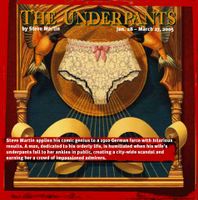
Tuesday, March 15th. Meg’s worked her magic and gotten us a pair of tickets to The Rep’s production of Steve Martin’s The Underpants. She picks me up at work and we head downtown. After circling a couple city blocks, we find a parking spot and walk over to the Milwaukee Center. I wish I’d thought to wear a heavier coat. The tickets are waiting at Will Call. As we make our way to the box office, I get my first glimpses of the style of the production. A TV monitor is playing a loop of short scenes from the play. There’s Deborah Staples entering a door, now reading a letter… she’s wearing a traditional German bodice and skirt. This takes me by surprise as I’m not yet familiar with the play and don’t realize that it’s set in 1910 Germany. Our short visit to the box office gives me a chance to look over the promotional posters for this season’s shows. I’m sorry to say I don’t know who designed/created them, but they deserve at least 83 hot fudge sundaes with extra hot fudge sundae. They look cool.
We’ve got 45 minutes before the curtain and we’re both hungry, so we run across the street to The Safe House for a quick bite. They were great—best speedy service I’ve seen at a restaurant. Imagine: you tell the hostess and server that you’re in a hurry and they actually respond by serving you quickly and getting your check as soon as possible. Kudos to the Safe House.
So 15 minutes before curtain, we’re crossing the street again and making our way into the Stiemke Theatre. It’s a smaller space than I expected, seating maybe—oh boy, I was never good at estimating quantities—300 people max? The first thing you notice is the whimsical set. The colors are vivid. Bright blues in the walls, reds and yellows in the table and chairs, greens reds and yellows in the sitting room. The walls arch out from the center (imagine a blooming flower) with the tops of the walls a good three feet wider than their feet. The whimsical set, combined with the pre-show polka music, reminded me of something King Ludwig II of Bavaria might have commissioned when he wasn’t prancing around with Wagner. Hanging downstage center is a sign announcing “Zimmer Frei”. OK. We’re in 1910 Germany, this small home has a room for rent, and reality is a bit warped. Bring it on.
Bring it on they did. By “they” I mean every one of the actors, director Risa Brainin, Steve Martin and Carl Sternheim. Who? Yes, German playwright Carl Sternheim. I’d be remiss if I didn’t mention that this play is Martin’s adaptation of a Sternheim satirical comedy from around the time in which The Underpants is set.
Where do I begin? Let me first say that we especially came to see Ryan Schabach in the production. He played the King, who has only a couple lines at the end of the show. He was wonderful. Everyone was wonderful. I can’t remember when I’ve seen such a strong cast. So… where to begin? Physicality. This isn’t a very physical script, at least not on the surface, but Brainin and the cast brought quite a bit of physical action to the scenes. From melodramatic gesturing to climbing on tables and over chairs so nonchalantly that it gets a laugh from the audience—as much because of the absurdity as because they caught themselves going along with it. One of my favorite moments was a lustful exchange between Versati, played dashingly by Dougfred Miller, and Louise, played by Deborah Staples. Louise is carrying a large bowl of cream, and when Versati has backed her into the table, her hands go back to catch herself, leaving the bowl braced between their bodies. It was a nicely choreographed bit.
Steve Pickering plays Theo, Louise’s husband. He captures the fun in the male chauvinist stereotype as Steve Martin has written it. That’s something I’ve noticed Martin likes to do: take on social stereotypes and satirize them by letting them announce boldly and confidently those things that unmask their foibles to the audience. It’s not way over the top, but he’s able to build the scenes and the timing so that the straight-forward comments come across as absurd. Pickering played a loveable detestable husband in the Torvald Helmer vein. He kicks off our ride and lets us know everything’s going to be great.
Staples as Louise is the show’s lead character. Actually, it’s her underpants that have the title role. We learn that as she was watching the King pass in the parade, she stood on her tiptoes for a better view and her underpants slipped down, drawing the attention of at least three bystanders and becoming the talk of the town. Staples’ spirited performance was well balanced—at once innocent and a bit daring. She carries us through the whole story and we’re happy to come along.
Ross Lehman as Cohen and Dougfred Miller as Versati are… well, very nearly perfect. Versati is a handsome gentleman poet who has come to rent the room because he’s enamored of Louise after her display at the parade. Louise’s friend and upstairs neighbor, Gertrude, played by Carole Healey, encourages her to give Versati the room and pursue an affair with him. In the meantime, Cohen has been promised the room by Theo; but for no less lascivious reasons. Lehman plays the “what, me Jewish?” character to a T. Hilarity ensues. A third man, Klinglehoff, played to riotous laughter by Jim Baker, comes inquiring about the room in the second act. Again, hats off to Steve Martin’s timing. Klinglehoff is the ultimate straight man to all of the zaniness that’s primed to explode in the play’s rapid-fire laugh fest climax.
The Underpants is running through March 27th in its extended run. Congratulations to The Rep, the cast, crew, designers and director for a wonderfully entertaining and successful show!
http://www.milwaukeerep.com/0405season/pages/STMK/TheUnderpants.asp
http://www.safe-house.com/





